Introduction to Marketing: Tesco and Mark Spencer Analysis
VerifiedAdded on 2020/06/06
|10
|2818
|325
Report
AI Summary
This report provides an introduction to marketing, focusing on the strategies of Tesco and Mark Spencer. It examines marketing techniques like the Ansoff Matrix, market penetration, product development, and diversification. The report analyzes limitations and constraints in marketing, including legal and regulatory factors such as the Sales of Goods Act and consumer protection regulations. It explores how marketing research, both qualitative and quantitative, contributes to developing marketing plans, including SWOT analysis. The report also discusses market segmentation, targeting customer groups, and developing a coherent marketing mix, incorporating the 7 Ps: Product, Price, Place, Promotion, People, Process, and Physical Evidence. It highlights the importance of customer and consumer distinctions in marketing strategies.
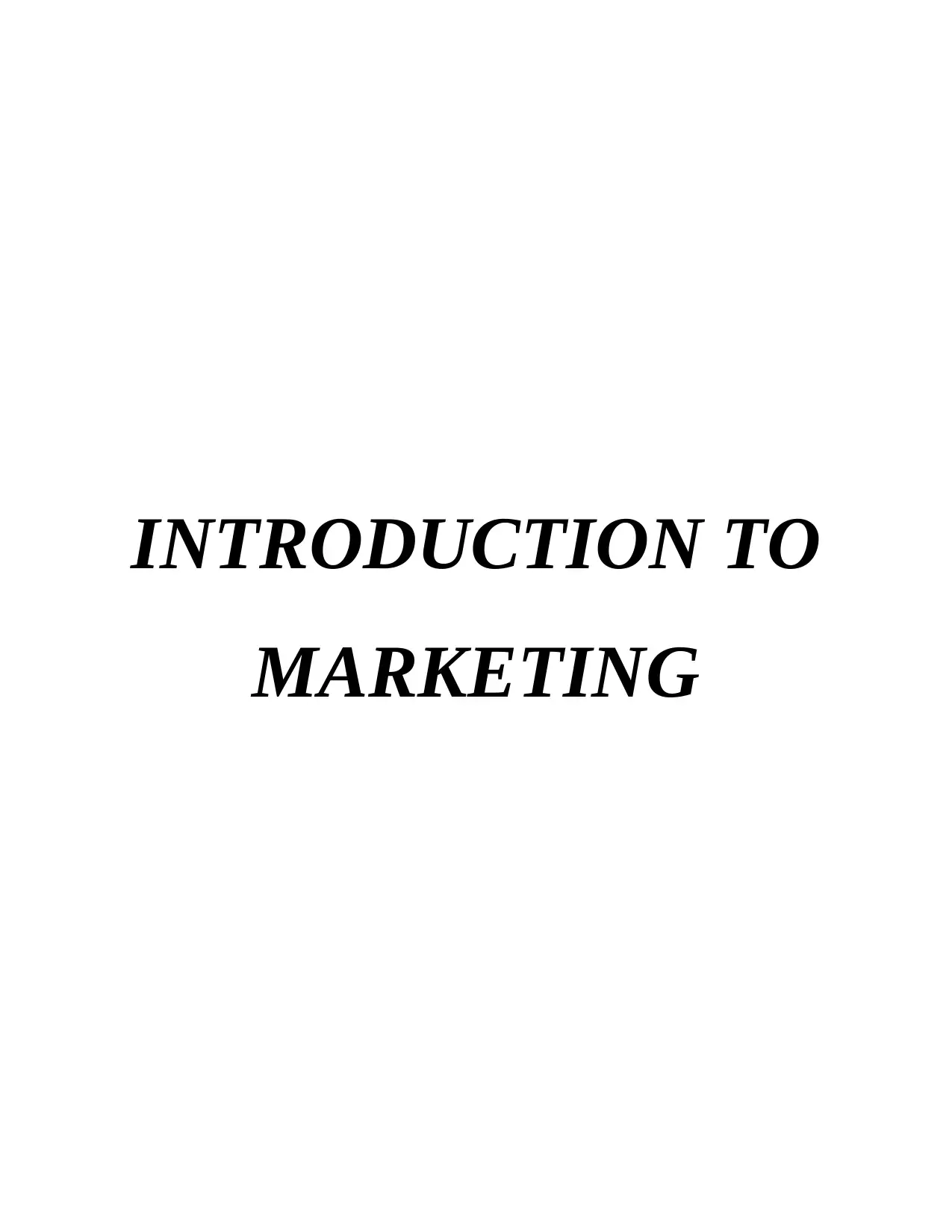
INTRODUCTION TO
MARKETING
MARKETING
Paraphrase This Document
Need a fresh take? Get an instant paraphrase of this document with our AI Paraphraser
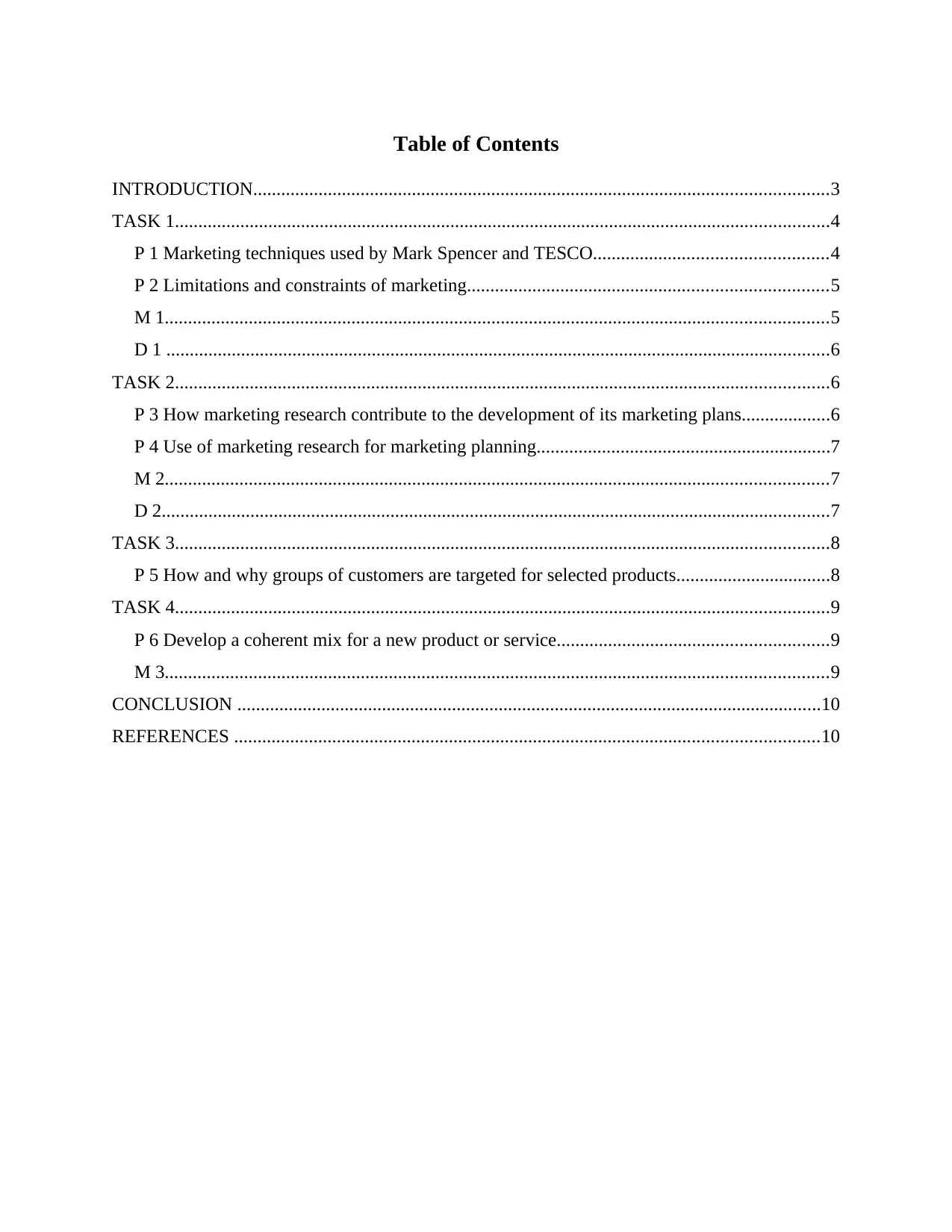
Table of Contents
INTRODUCTION...........................................................................................................................3
TASK 1............................................................................................................................................4
P 1 Marketing techniques used by Mark Spencer and TESCO..................................................4
P 2 Limitations and constraints of marketing.............................................................................5
M 1..............................................................................................................................................5
D 1 ..............................................................................................................................................6
TASK 2............................................................................................................................................6
P 3 How marketing research contribute to the development of its marketing plans...................6
P 4 Use of marketing research for marketing planning...............................................................7
M 2..............................................................................................................................................7
D 2...............................................................................................................................................7
TASK 3............................................................................................................................................8
P 5 How and why groups of customers are targeted for selected products.................................8
TASK 4............................................................................................................................................9
P 6 Develop a coherent mix for a new product or service..........................................................9
M 3..............................................................................................................................................9
CONCLUSION .............................................................................................................................10
REFERENCES .............................................................................................................................10
INTRODUCTION...........................................................................................................................3
TASK 1............................................................................................................................................4
P 1 Marketing techniques used by Mark Spencer and TESCO..................................................4
P 2 Limitations and constraints of marketing.............................................................................5
M 1..............................................................................................................................................5
D 1 ..............................................................................................................................................6
TASK 2............................................................................................................................................6
P 3 How marketing research contribute to the development of its marketing plans...................6
P 4 Use of marketing research for marketing planning...............................................................7
M 2..............................................................................................................................................7
D 2...............................................................................................................................................7
TASK 3............................................................................................................................................8
P 5 How and why groups of customers are targeted for selected products.................................8
TASK 4............................................................................................................................................9
P 6 Develop a coherent mix for a new product or service..........................................................9
M 3..............................................................................................................................................9
CONCLUSION .............................................................................................................................10
REFERENCES .............................................................................................................................10
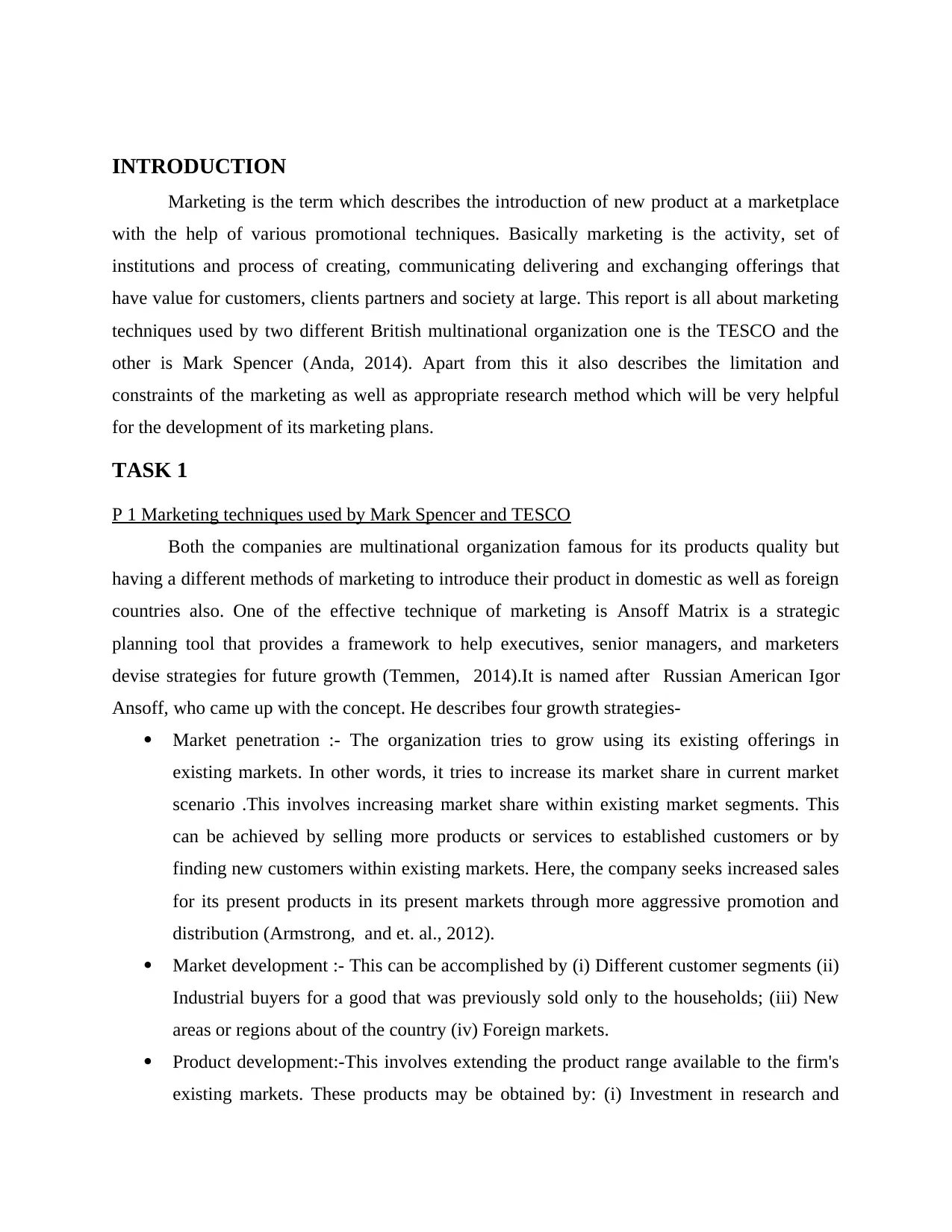
INTRODUCTION
Marketing is the term which describes the introduction of new product at a marketplace
with the help of various promotional techniques. Basically marketing is the activity, set of
institutions and process of creating, communicating delivering and exchanging offerings that
have value for customers, clients partners and society at large. This report is all about marketing
techniques used by two different British multinational organization one is the TESCO and the
other is Mark Spencer (Anda, 2014). Apart from this it also describes the limitation and
constraints of the marketing as well as appropriate research method which will be very helpful
for the development of its marketing plans.
TASK 1
P 1 Marketing techniques used by Mark Spencer and TESCO
Both the companies are multinational organization famous for its products quality but
having a different methods of marketing to introduce their product in domestic as well as foreign
countries also. One of the effective technique of marketing is Ansoff Matrix is a strategic
planning tool that provides a framework to help executives, senior managers, and marketers
devise strategies for future growth (Temmen, 2014).It is named after Russian American Igor
Ansoff, who came up with the concept. He describes four growth strategies-
Market penetration :- The organization tries to grow using its existing offerings in
existing markets. In other words, it tries to increase its market share in current market
scenario .This involves increasing market share within existing market segments. This
can be achieved by selling more products or services to established customers or by
finding new customers within existing markets. Here, the company seeks increased sales
for its present products in its present markets through more aggressive promotion and
distribution (Armstrong, and et. al., 2012).
Market development :- This can be accomplished by (i) Different customer segments (ii)
Industrial buyers for a good that was previously sold only to the households; (iii) New
areas or regions about of the country (iv) Foreign markets.
Product development:-This involves extending the product range available to the firm's
existing markets. These products may be obtained by: (i) Investment in research and
Marketing is the term which describes the introduction of new product at a marketplace
with the help of various promotional techniques. Basically marketing is the activity, set of
institutions and process of creating, communicating delivering and exchanging offerings that
have value for customers, clients partners and society at large. This report is all about marketing
techniques used by two different British multinational organization one is the TESCO and the
other is Mark Spencer (Anda, 2014). Apart from this it also describes the limitation and
constraints of the marketing as well as appropriate research method which will be very helpful
for the development of its marketing plans.
TASK 1
P 1 Marketing techniques used by Mark Spencer and TESCO
Both the companies are multinational organization famous for its products quality but
having a different methods of marketing to introduce their product in domestic as well as foreign
countries also. One of the effective technique of marketing is Ansoff Matrix is a strategic
planning tool that provides a framework to help executives, senior managers, and marketers
devise strategies for future growth (Temmen, 2014).It is named after Russian American Igor
Ansoff, who came up with the concept. He describes four growth strategies-
Market penetration :- The organization tries to grow using its existing offerings in
existing markets. In other words, it tries to increase its market share in current market
scenario .This involves increasing market share within existing market segments. This
can be achieved by selling more products or services to established customers or by
finding new customers within existing markets. Here, the company seeks increased sales
for its present products in its present markets through more aggressive promotion and
distribution (Armstrong, and et. al., 2012).
Market development :- This can be accomplished by (i) Different customer segments (ii)
Industrial buyers for a good that was previously sold only to the households; (iii) New
areas or regions about of the country (iv) Foreign markets.
Product development:-This involves extending the product range available to the firm's
existing markets. These products may be obtained by: (i) Investment in research and
⊘ This is a preview!⊘
Do you want full access?
Subscribe today to unlock all pages.

Trusted by 1+ million students worldwide
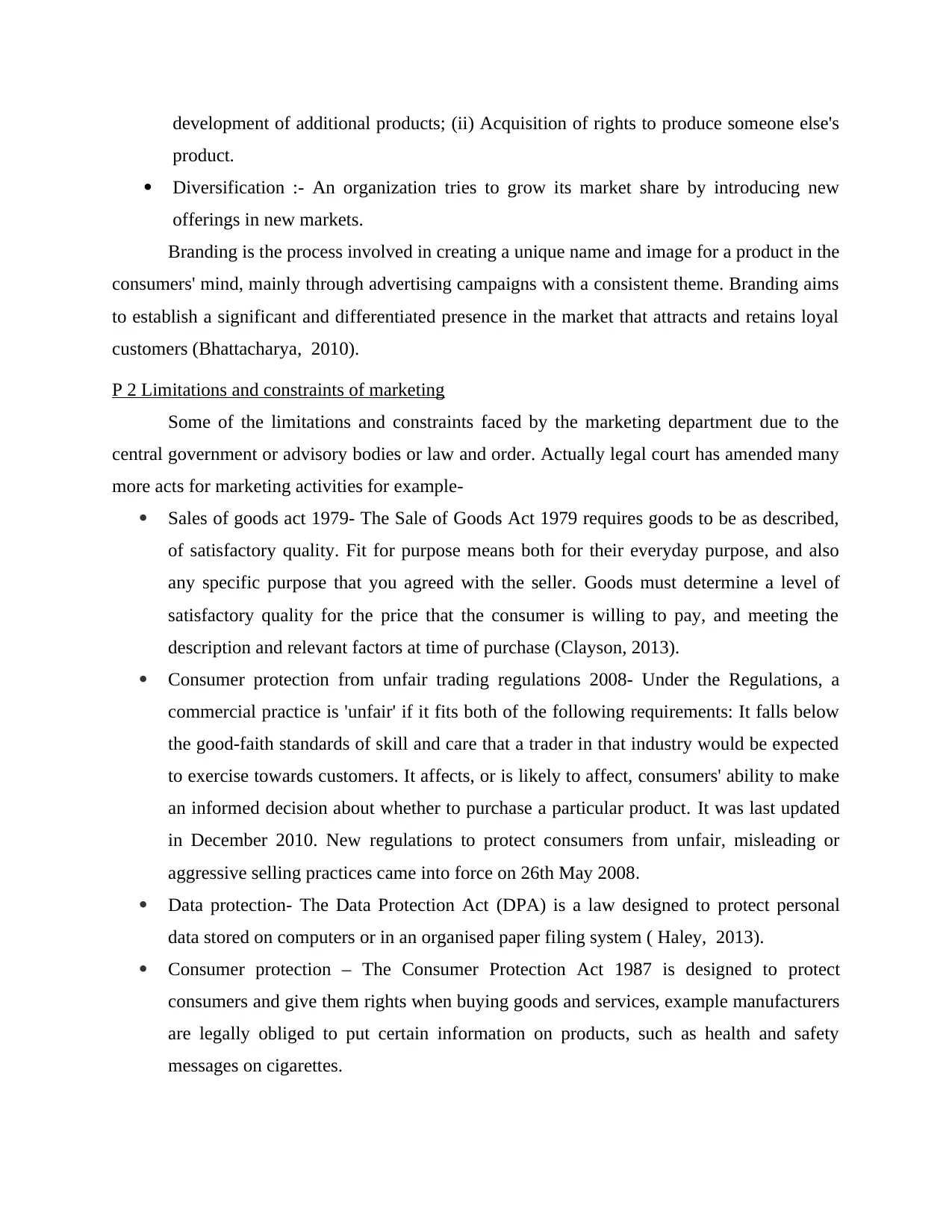
development of additional products; (ii) Acquisition of rights to produce someone else's
product.
Diversification :- An organization tries to grow its market share by introducing new
offerings in new markets.
Branding is the process involved in creating a unique name and image for a product in the
consumers' mind, mainly through advertising campaigns with a consistent theme. Branding aims
to establish a significant and differentiated presence in the market that attracts and retains loyal
customers (Bhattacharya, 2010).
P 2 Limitations and constraints of marketing
Some of the limitations and constraints faced by the marketing department due to the
central government or advisory bodies or law and order. Actually legal court has amended many
more acts for marketing activities for example-
Sales of goods act 1979- The Sale of Goods Act 1979 requires goods to be as described,
of satisfactory quality. Fit for purpose means both for their everyday purpose, and also
any specific purpose that you agreed with the seller. Goods must determine a level of
satisfactory quality for the price that the consumer is willing to pay, and meeting the
description and relevant factors at time of purchase (Clayson, 2013).
Consumer protection from unfair trading regulations 2008- Under the Regulations, a
commercial practice is 'unfair' if it fits both of the following requirements: It falls below
the good-faith standards of skill and care that a trader in that industry would be expected
to exercise towards customers. It affects, or is likely to affect, consumers' ability to make
an informed decision about whether to purchase a particular product. It was last updated
in December 2010. New regulations to protect consumers from unfair, misleading or
aggressive selling practices came into force on 26th May 2008.
Data protection- The Data Protection Act (DPA) is a law designed to protect personal
data stored on computers or in an organised paper filing system ( Haley, 2013).
Consumer protection – The Consumer Protection Act 1987 is designed to protect
consumers and give them rights when buying goods and services, example manufacturers
are legally obliged to put certain information on products, such as health and safety
messages on cigarettes.
product.
Diversification :- An organization tries to grow its market share by introducing new
offerings in new markets.
Branding is the process involved in creating a unique name and image for a product in the
consumers' mind, mainly through advertising campaigns with a consistent theme. Branding aims
to establish a significant and differentiated presence in the market that attracts and retains loyal
customers (Bhattacharya, 2010).
P 2 Limitations and constraints of marketing
Some of the limitations and constraints faced by the marketing department due to the
central government or advisory bodies or law and order. Actually legal court has amended many
more acts for marketing activities for example-
Sales of goods act 1979- The Sale of Goods Act 1979 requires goods to be as described,
of satisfactory quality. Fit for purpose means both for their everyday purpose, and also
any specific purpose that you agreed with the seller. Goods must determine a level of
satisfactory quality for the price that the consumer is willing to pay, and meeting the
description and relevant factors at time of purchase (Clayson, 2013).
Consumer protection from unfair trading regulations 2008- Under the Regulations, a
commercial practice is 'unfair' if it fits both of the following requirements: It falls below
the good-faith standards of skill and care that a trader in that industry would be expected
to exercise towards customers. It affects, or is likely to affect, consumers' ability to make
an informed decision about whether to purchase a particular product. It was last updated
in December 2010. New regulations to protect consumers from unfair, misleading or
aggressive selling practices came into force on 26th May 2008.
Data protection- The Data Protection Act (DPA) is a law designed to protect personal
data stored on computers or in an organised paper filing system ( Haley, 2013).
Consumer protection – The Consumer Protection Act 1987 is designed to protect
consumers and give them rights when buying goods and services, example manufacturers
are legally obliged to put certain information on products, such as health and safety
messages on cigarettes.
Paraphrase This Document
Need a fresh take? Get an instant paraphrase of this document with our AI Paraphraser
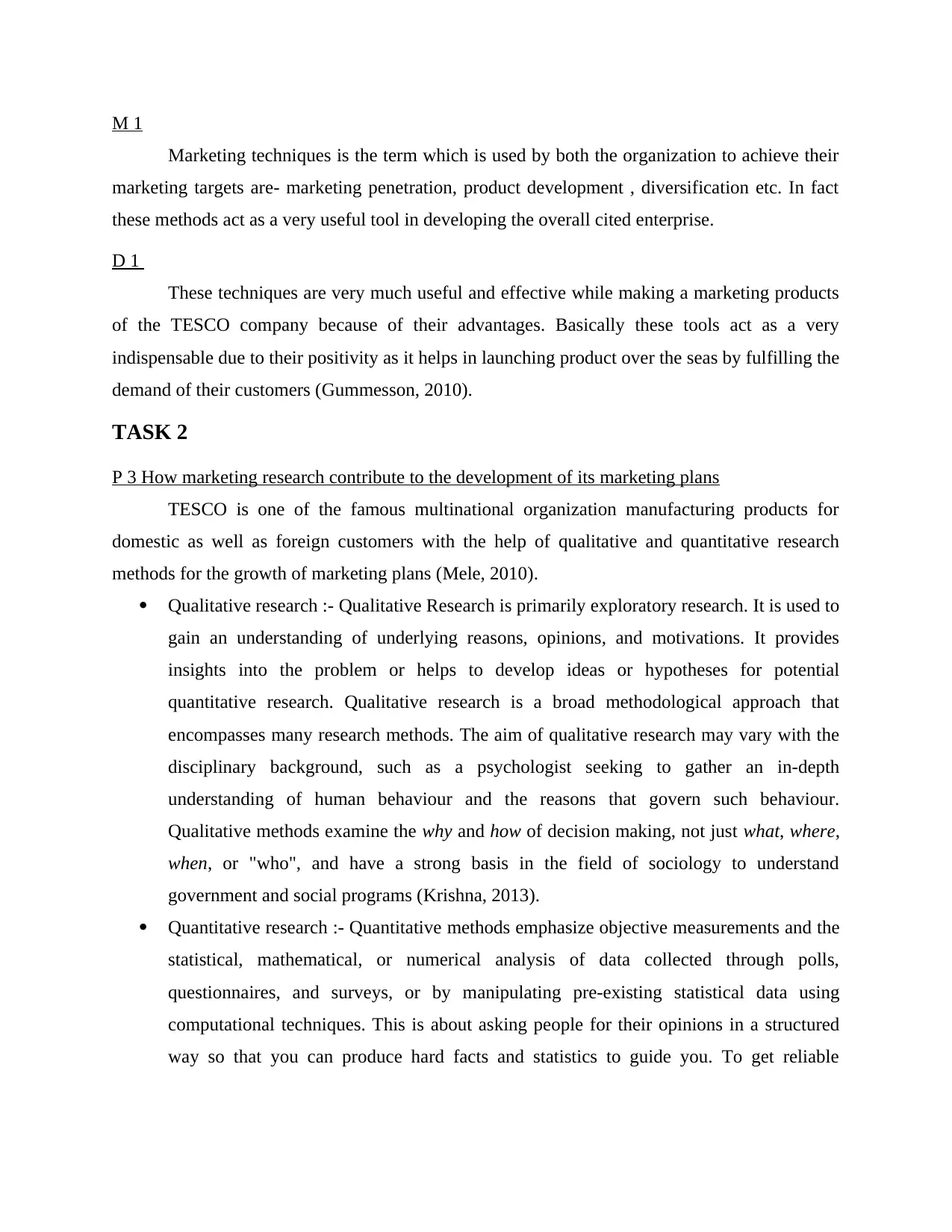
M 1
Marketing techniques is the term which is used by both the organization to achieve their
marketing targets are- marketing penetration, product development , diversification etc. In fact
these methods act as a very useful tool in developing the overall cited enterprise.
D 1
These techniques are very much useful and effective while making a marketing products
of the TESCO company because of their advantages. Basically these tools act as a very
indispensable due to their positivity as it helps in launching product over the seas by fulfilling the
demand of their customers (Gummesson, 2010).
TASK 2
P 3 How marketing research contribute to the development of its marketing plans
TESCO is one of the famous multinational organization manufacturing products for
domestic as well as foreign customers with the help of qualitative and quantitative research
methods for the growth of marketing plans (Mele, 2010).
Qualitative research :- Qualitative Research is primarily exploratory research. It is used to
gain an understanding of underlying reasons, opinions, and motivations. It provides
insights into the problem or helps to develop ideas or hypotheses for potential
quantitative research. Qualitative research is a broad methodological approach that
encompasses many research methods. The aim of qualitative research may vary with the
disciplinary background, such as a psychologist seeking to gather an in-depth
understanding of human behaviour and the reasons that govern such behaviour.
Qualitative methods examine the why and how of decision making, not just what, where,
when, or "who", and have a strong basis in the field of sociology to understand
government and social programs (Krishna, 2013).
Quantitative research :- Quantitative methods emphasize objective measurements and the
statistical, mathematical, or numerical analysis of data collected through polls,
questionnaires, and surveys, or by manipulating pre-existing statistical data using
computational techniques. This is about asking people for their opinions in a structured
way so that you can produce hard facts and statistics to guide you. To get reliable
Marketing techniques is the term which is used by both the organization to achieve their
marketing targets are- marketing penetration, product development , diversification etc. In fact
these methods act as a very useful tool in developing the overall cited enterprise.
D 1
These techniques are very much useful and effective while making a marketing products
of the TESCO company because of their advantages. Basically these tools act as a very
indispensable due to their positivity as it helps in launching product over the seas by fulfilling the
demand of their customers (Gummesson, 2010).
TASK 2
P 3 How marketing research contribute to the development of its marketing plans
TESCO is one of the famous multinational organization manufacturing products for
domestic as well as foreign customers with the help of qualitative and quantitative research
methods for the growth of marketing plans (Mele, 2010).
Qualitative research :- Qualitative Research is primarily exploratory research. It is used to
gain an understanding of underlying reasons, opinions, and motivations. It provides
insights into the problem or helps to develop ideas or hypotheses for potential
quantitative research. Qualitative research is a broad methodological approach that
encompasses many research methods. The aim of qualitative research may vary with the
disciplinary background, such as a psychologist seeking to gather an in-depth
understanding of human behaviour and the reasons that govern such behaviour.
Qualitative methods examine the why and how of decision making, not just what, where,
when, or "who", and have a strong basis in the field of sociology to understand
government and social programs (Krishna, 2013).
Quantitative research :- Quantitative methods emphasize objective measurements and the
statistical, mathematical, or numerical analysis of data collected through polls,
questionnaires, and surveys, or by manipulating pre-existing statistical data using
computational techniques. This is about asking people for their opinions in a structured
way so that you can produce hard facts and statistics to guide you. To get reliable
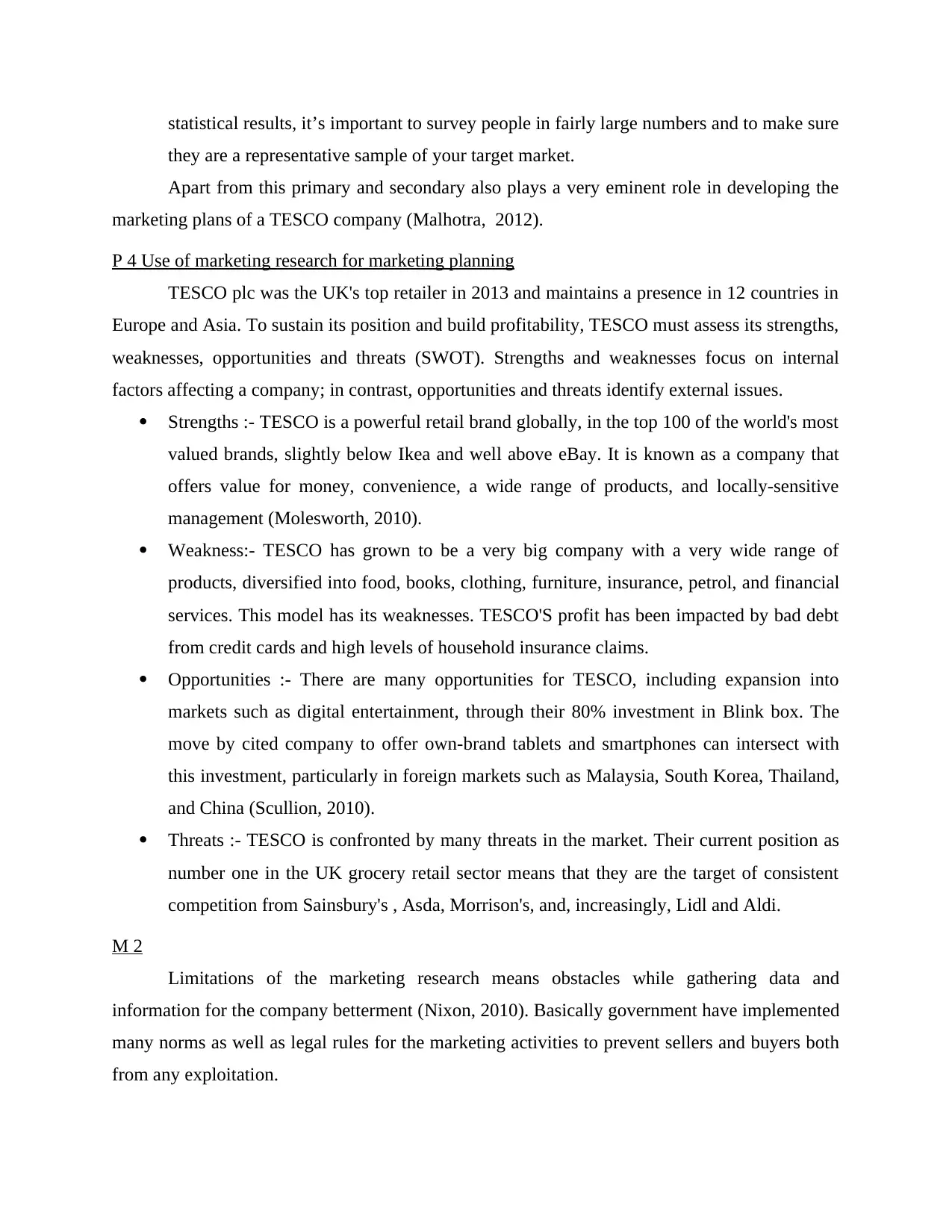
statistical results, it’s important to survey people in fairly large numbers and to make sure
they are a representative sample of your target market.
Apart from this primary and secondary also plays a very eminent role in developing the
marketing plans of a TESCO company (Malhotra, 2012).
P 4 Use of marketing research for marketing planning
TESCO plc was the UK's top retailer in 2013 and maintains a presence in 12 countries in
Europe and Asia. To sustain its position and build profitability, TESCO must assess its strengths,
weaknesses, opportunities and threats (SWOT). Strengths and weaknesses focus on internal
factors affecting a company; in contrast, opportunities and threats identify external issues.
Strengths :- TESCO is a powerful retail brand globally, in the top 100 of the world's most
valued brands, slightly below Ikea and well above eBay. It is known as a company that
offers value for money, convenience, a wide range of products, and locally-sensitive
management (Molesworth, 2010).
Weakness:- TESCO has grown to be a very big company with a very wide range of
products, diversified into food, books, clothing, furniture, insurance, petrol, and financial
services. This model has its weaknesses. TESCO'S profit has been impacted by bad debt
from credit cards and high levels of household insurance claims.
Opportunities :- There are many opportunities for TESCO, including expansion into
markets such as digital entertainment, through their 80% investment in Blink box. The
move by cited company to offer own-brand tablets and smartphones can intersect with
this investment, particularly in foreign markets such as Malaysia, South Korea, Thailand,
and China (Scullion, 2010).
Threats :- TESCO is confronted by many threats in the market. Their current position as
number one in the UK grocery retail sector means that they are the target of consistent
competition from Sainsbury's , Asda, Morrison's, and, increasingly, Lidl and Aldi.
M 2
Limitations of the marketing research means obstacles while gathering data and
information for the company betterment (Nixon, 2010). Basically government have implemented
many norms as well as legal rules for the marketing activities to prevent sellers and buyers both
from any exploitation.
they are a representative sample of your target market.
Apart from this primary and secondary also plays a very eminent role in developing the
marketing plans of a TESCO company (Malhotra, 2012).
P 4 Use of marketing research for marketing planning
TESCO plc was the UK's top retailer in 2013 and maintains a presence in 12 countries in
Europe and Asia. To sustain its position and build profitability, TESCO must assess its strengths,
weaknesses, opportunities and threats (SWOT). Strengths and weaknesses focus on internal
factors affecting a company; in contrast, opportunities and threats identify external issues.
Strengths :- TESCO is a powerful retail brand globally, in the top 100 of the world's most
valued brands, slightly below Ikea and well above eBay. It is known as a company that
offers value for money, convenience, a wide range of products, and locally-sensitive
management (Molesworth, 2010).
Weakness:- TESCO has grown to be a very big company with a very wide range of
products, diversified into food, books, clothing, furniture, insurance, petrol, and financial
services. This model has its weaknesses. TESCO'S profit has been impacted by bad debt
from credit cards and high levels of household insurance claims.
Opportunities :- There are many opportunities for TESCO, including expansion into
markets such as digital entertainment, through their 80% investment in Blink box. The
move by cited company to offer own-brand tablets and smartphones can intersect with
this investment, particularly in foreign markets such as Malaysia, South Korea, Thailand,
and China (Scullion, 2010).
Threats :- TESCO is confronted by many threats in the market. Their current position as
number one in the UK grocery retail sector means that they are the target of consistent
competition from Sainsbury's , Asda, Morrison's, and, increasingly, Lidl and Aldi.
M 2
Limitations of the marketing research means obstacles while gathering data and
information for the company betterment (Nixon, 2010). Basically government have implemented
many norms as well as legal rules for the marketing activities to prevent sellers and buyers both
from any exploitation.
⊘ This is a preview!⊘
Do you want full access?
Subscribe today to unlock all pages.

Trusted by 1+ million students worldwide
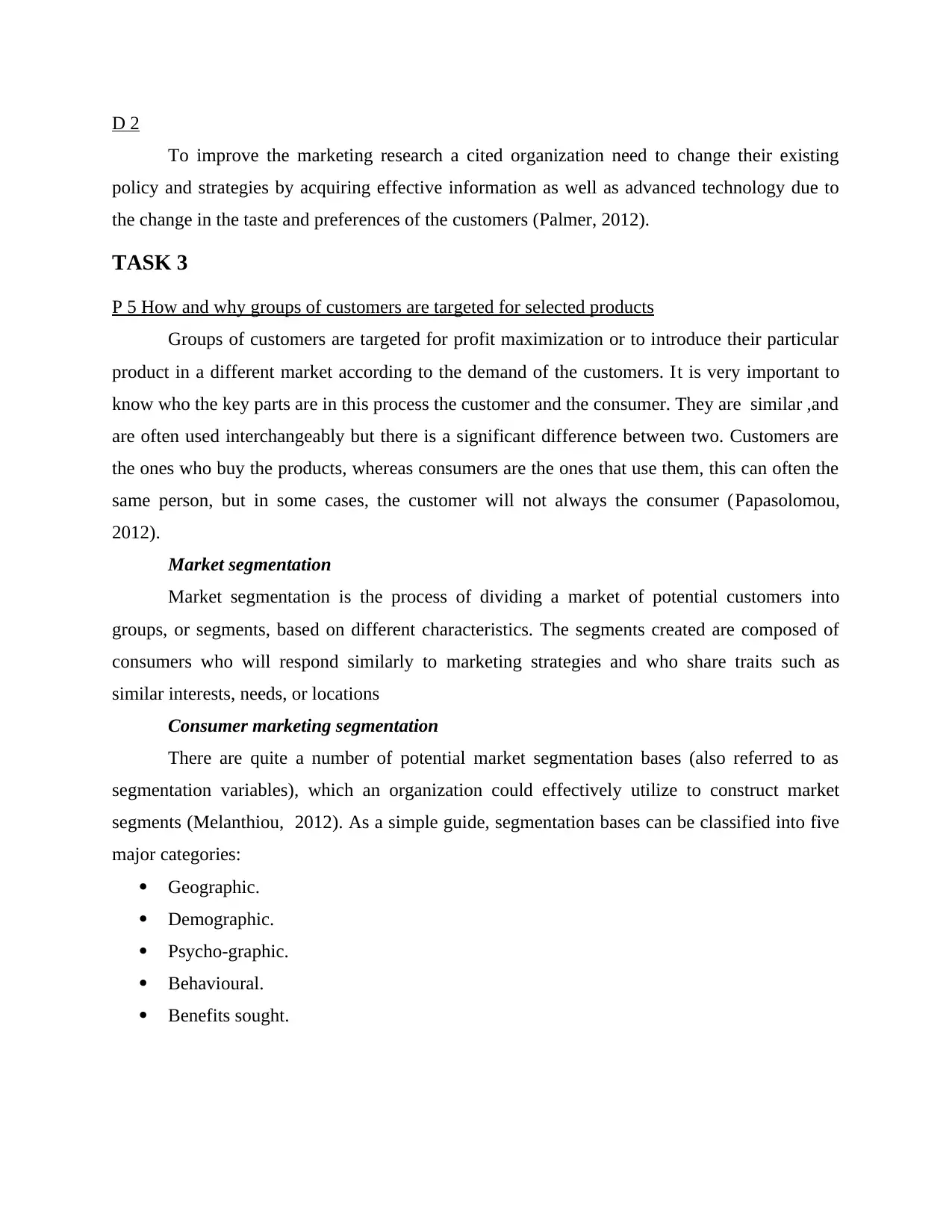
D 2
To improve the marketing research a cited organization need to change their existing
policy and strategies by acquiring effective information as well as advanced technology due to
the change in the taste and preferences of the customers (Palmer, 2012).
TASK 3
P 5 How and why groups of customers are targeted for selected products
Groups of customers are targeted for profit maximization or to introduce their particular
product in a different market according to the demand of the customers. It is very important to
know who the key parts are in this process the customer and the consumer. They are similar ,and
are often used interchangeably but there is a significant difference between two. Customers are
the ones who buy the products, whereas consumers are the ones that use them, this can often the
same person, but in some cases, the customer will not always the consumer (Papasolomou,
2012).
Market segmentation
Market segmentation is the process of dividing a market of potential customers into
groups, or segments, based on different characteristics. The segments created are composed of
consumers who will respond similarly to marketing strategies and who share traits such as
similar interests, needs, or locations
Consumer marketing segmentation
There are quite a number of potential market segmentation bases (also referred to as
segmentation variables), which an organization could effectively utilize to construct market
segments (Melanthiou, 2012). As a simple guide, segmentation bases can be classified into five
major categories:
Geographic.
Demographic.
Psycho-graphic.
Behavioural.
Benefits sought.
To improve the marketing research a cited organization need to change their existing
policy and strategies by acquiring effective information as well as advanced technology due to
the change in the taste and preferences of the customers (Palmer, 2012).
TASK 3
P 5 How and why groups of customers are targeted for selected products
Groups of customers are targeted for profit maximization or to introduce their particular
product in a different market according to the demand of the customers. It is very important to
know who the key parts are in this process the customer and the consumer. They are similar ,and
are often used interchangeably but there is a significant difference between two. Customers are
the ones who buy the products, whereas consumers are the ones that use them, this can often the
same person, but in some cases, the customer will not always the consumer (Papasolomou,
2012).
Market segmentation
Market segmentation is the process of dividing a market of potential customers into
groups, or segments, based on different characteristics. The segments created are composed of
consumers who will respond similarly to marketing strategies and who share traits such as
similar interests, needs, or locations
Consumer marketing segmentation
There are quite a number of potential market segmentation bases (also referred to as
segmentation variables), which an organization could effectively utilize to construct market
segments (Melanthiou, 2012). As a simple guide, segmentation bases can be classified into five
major categories:
Geographic.
Demographic.
Psycho-graphic.
Behavioural.
Benefits sought.
Paraphrase This Document
Need a fresh take? Get an instant paraphrase of this document with our AI Paraphraser
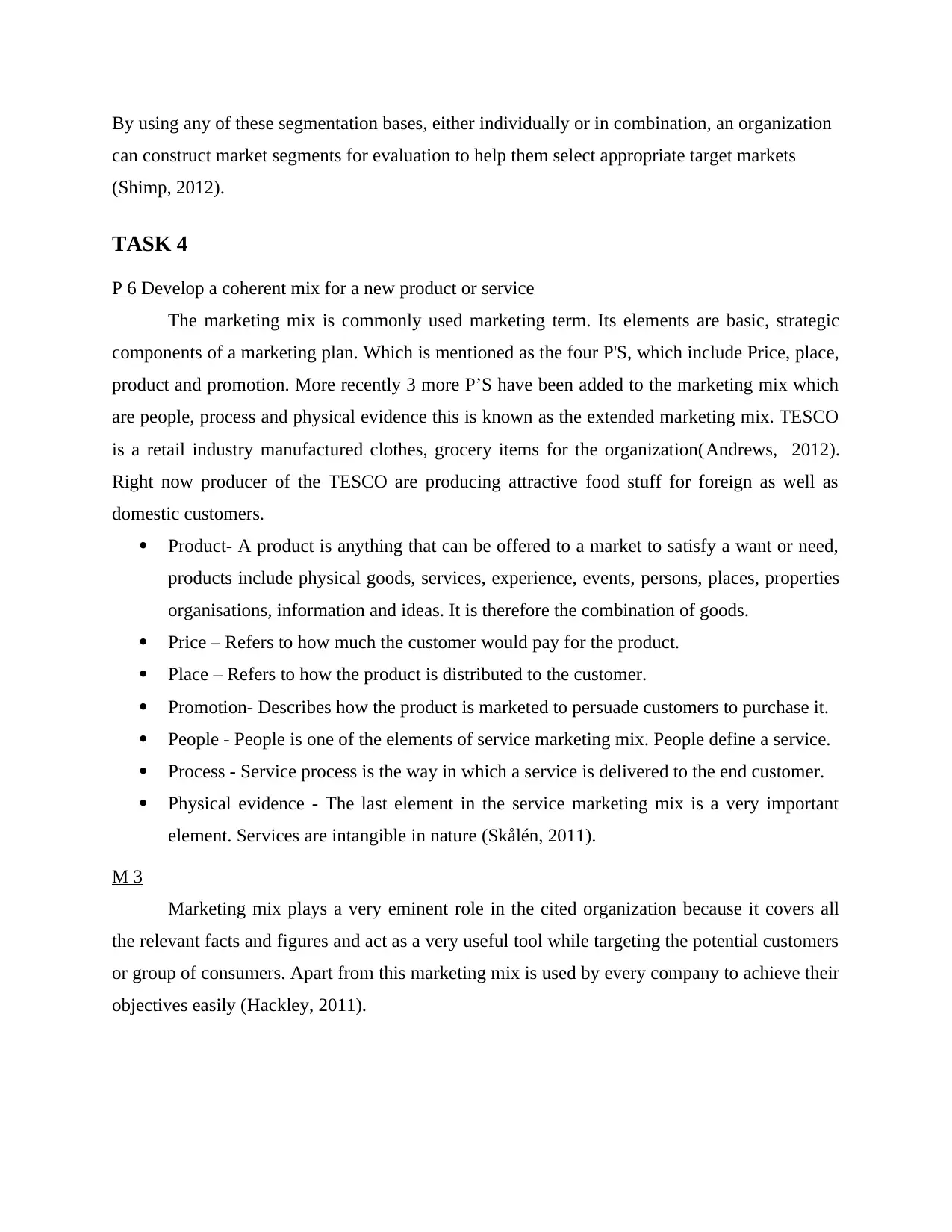
By using any of these segmentation bases, either individually or in combination, an organization
can construct market segments for evaluation to help them select appropriate target markets
(Shimp, 2012).
TASK 4
P 6 Develop a coherent mix for a new product or service
The marketing mix is commonly used marketing term. Its elements are basic, strategic
components of a marketing plan. Which is mentioned as the four P'S, which include Price, place,
product and promotion. More recently 3 more P’S have been added to the marketing mix which
are people, process and physical evidence this is known as the extended marketing mix. TESCO
is a retail industry manufactured clothes, grocery items for the organization(Andrews, 2012).
Right now producer of the TESCO are producing attractive food stuff for foreign as well as
domestic customers.
Product- A product is anything that can be offered to a market to satisfy a want or need,
products include physical goods, services, experience, events, persons, places, properties
organisations, information and ideas. It is therefore the combination of goods.
Price – Refers to how much the customer would pay for the product.
Place – Refers to how the product is distributed to the customer.
Promotion- Describes how the product is marketed to persuade customers to purchase it.
People - People is one of the elements of service marketing mix. People define a service.
Process - Service process is the way in which a service is delivered to the end customer.
Physical evidence - The last element in the service marketing mix is a very important
element. Services are intangible in nature (Skålén, 2011).
M 3
Marketing mix plays a very eminent role in the cited organization because it covers all
the relevant facts and figures and act as a very useful tool while targeting the potential customers
or group of consumers. Apart from this marketing mix is used by every company to achieve their
objectives easily (Hackley, 2011).
can construct market segments for evaluation to help them select appropriate target markets
(Shimp, 2012).
TASK 4
P 6 Develop a coherent mix for a new product or service
The marketing mix is commonly used marketing term. Its elements are basic, strategic
components of a marketing plan. Which is mentioned as the four P'S, which include Price, place,
product and promotion. More recently 3 more P’S have been added to the marketing mix which
are people, process and physical evidence this is known as the extended marketing mix. TESCO
is a retail industry manufactured clothes, grocery items for the organization(Andrews, 2012).
Right now producer of the TESCO are producing attractive food stuff for foreign as well as
domestic customers.
Product- A product is anything that can be offered to a market to satisfy a want or need,
products include physical goods, services, experience, events, persons, places, properties
organisations, information and ideas. It is therefore the combination of goods.
Price – Refers to how much the customer would pay for the product.
Place – Refers to how the product is distributed to the customer.
Promotion- Describes how the product is marketed to persuade customers to purchase it.
People - People is one of the elements of service marketing mix. People define a service.
Process - Service process is the way in which a service is delivered to the end customer.
Physical evidence - The last element in the service marketing mix is a very important
element. Services are intangible in nature (Skålén, 2011).
M 3
Marketing mix plays a very eminent role in the cited organization because it covers all
the relevant facts and figures and act as a very useful tool while targeting the potential customers
or group of consumers. Apart from this marketing mix is used by every company to achieve their
objectives easily (Hackley, 2011).
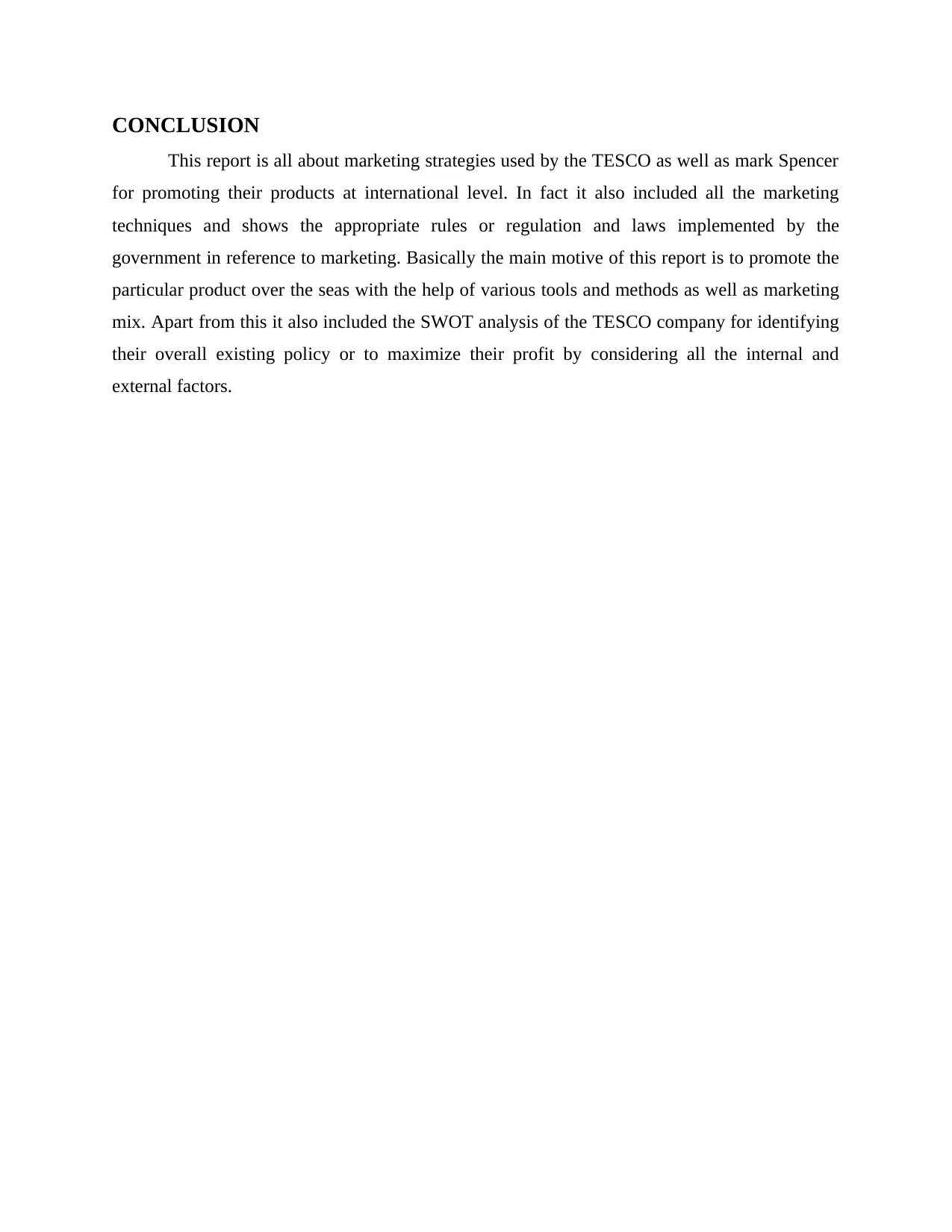
CONCLUSION
This report is all about marketing strategies used by the TESCO as well as mark Spencer
for promoting their products at international level. In fact it also included all the marketing
techniques and shows the appropriate rules or regulation and laws implemented by the
government in reference to marketing. Basically the main motive of this report is to promote the
particular product over the seas with the help of various tools and methods as well as marketing
mix. Apart from this it also included the SWOT analysis of the TESCO company for identifying
their overall existing policy or to maximize their profit by considering all the internal and
external factors.
This report is all about marketing strategies used by the TESCO as well as mark Spencer
for promoting their products at international level. In fact it also included all the marketing
techniques and shows the appropriate rules or regulation and laws implemented by the
government in reference to marketing. Basically the main motive of this report is to promote the
particular product over the seas with the help of various tools and methods as well as marketing
mix. Apart from this it also included the SWOT analysis of the TESCO company for identifying
their overall existing policy or to maximize their profit by considering all the internal and
external factors.
⊘ This is a preview!⊘
Do you want full access?
Subscribe today to unlock all pages.

Trusted by 1+ million students worldwide
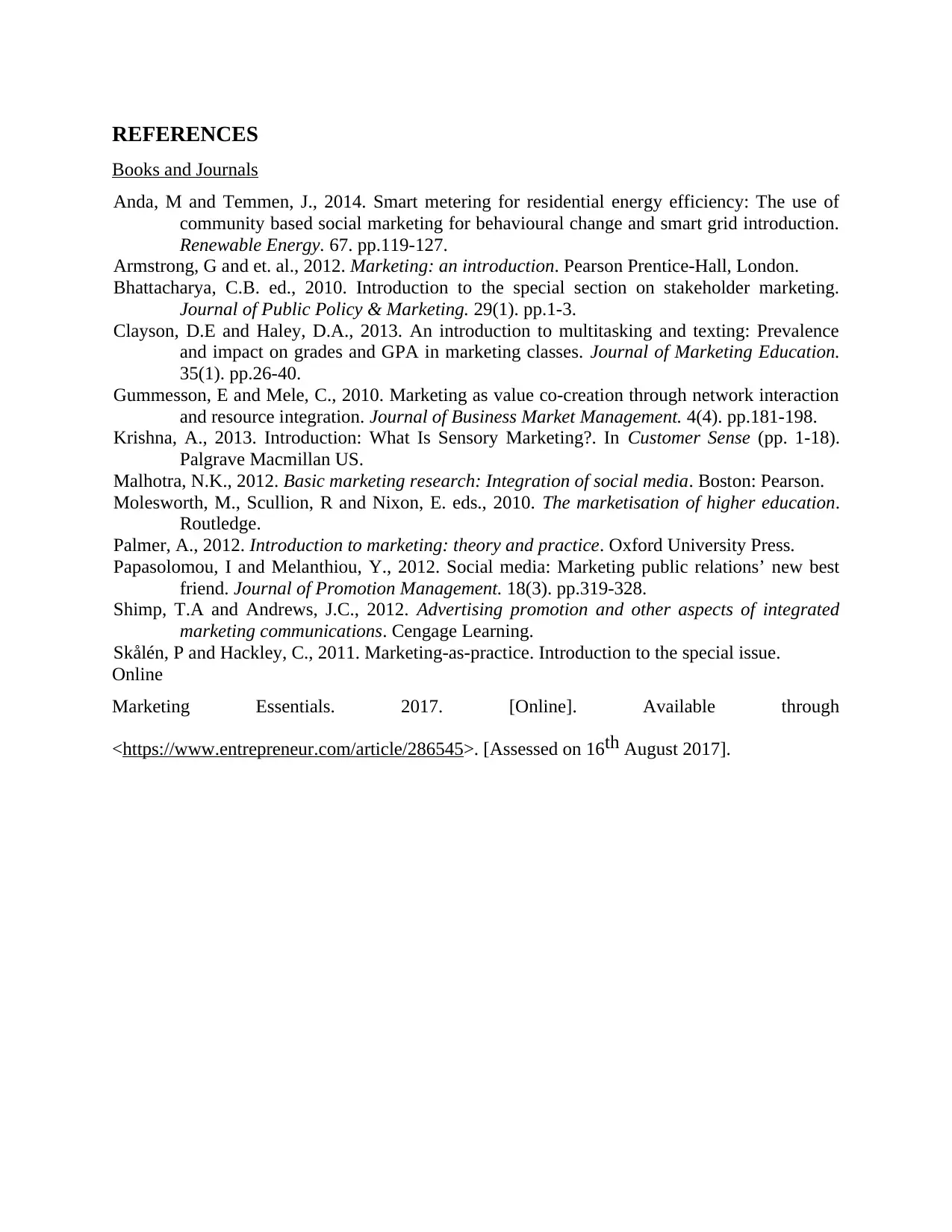
REFERENCES
Books and Journals
Anda, M and Temmen, J., 2014. Smart metering for residential energy efficiency: The use of
community based social marketing for behavioural change and smart grid introduction.
Renewable Energy. 67. pp.119-127.
Armstrong, G and et. al., 2012. Marketing: an introduction. Pearson Prentice-Hall, London.
Bhattacharya, C.B. ed., 2010. Introduction to the special section on stakeholder marketing.
Journal of Public Policy & Marketing. 29(1). pp.1-3.
Clayson, D.E and Haley, D.A., 2013. An introduction to multitasking and texting: Prevalence
and impact on grades and GPA in marketing classes. Journal of Marketing Education.
35(1). pp.26-40.
Gummesson, E and Mele, C., 2010. Marketing as value co-creation through network interaction
and resource integration. Journal of Business Market Management. 4(4). pp.181-198.
Krishna, A., 2013. Introduction: What Is Sensory Marketing?. In Customer Sense (pp. 1-18).
Palgrave Macmillan US.
Malhotra, N.K., 2012. Basic marketing research: Integration of social media. Boston: Pearson.
Molesworth, M., Scullion, R and Nixon, E. eds., 2010. The marketisation of higher education.
Routledge.
Palmer, A., 2012. Introduction to marketing: theory and practice. Oxford University Press.
Papasolomou, I and Melanthiou, Y., 2012. Social media: Marketing public relations’ new best
friend. Journal of Promotion Management. 18(3). pp.319-328.
Shimp, T.A and Andrews, J.C., 2012. Advertising promotion and other aspects of integrated
marketing communications. Cengage Learning.
Skålén, P and Hackley, C., 2011. Marketing-as-practice. Introduction to the special issue.
Online
Marketing Essentials. 2017. [Online]. Available through
<https://www.entrepreneur.com/article/286545>. [Assessed on 16th August 2017].
Books and Journals
Anda, M and Temmen, J., 2014. Smart metering for residential energy efficiency: The use of
community based social marketing for behavioural change and smart grid introduction.
Renewable Energy. 67. pp.119-127.
Armstrong, G and et. al., 2012. Marketing: an introduction. Pearson Prentice-Hall, London.
Bhattacharya, C.B. ed., 2010. Introduction to the special section on stakeholder marketing.
Journal of Public Policy & Marketing. 29(1). pp.1-3.
Clayson, D.E and Haley, D.A., 2013. An introduction to multitasking and texting: Prevalence
and impact on grades and GPA in marketing classes. Journal of Marketing Education.
35(1). pp.26-40.
Gummesson, E and Mele, C., 2010. Marketing as value co-creation through network interaction
and resource integration. Journal of Business Market Management. 4(4). pp.181-198.
Krishna, A., 2013. Introduction: What Is Sensory Marketing?. In Customer Sense (pp. 1-18).
Palgrave Macmillan US.
Malhotra, N.K., 2012. Basic marketing research: Integration of social media. Boston: Pearson.
Molesworth, M., Scullion, R and Nixon, E. eds., 2010. The marketisation of higher education.
Routledge.
Palmer, A., 2012. Introduction to marketing: theory and practice. Oxford University Press.
Papasolomou, I and Melanthiou, Y., 2012. Social media: Marketing public relations’ new best
friend. Journal of Promotion Management. 18(3). pp.319-328.
Shimp, T.A and Andrews, J.C., 2012. Advertising promotion and other aspects of integrated
marketing communications. Cengage Learning.
Skålén, P and Hackley, C., 2011. Marketing-as-practice. Introduction to the special issue.
Online
Marketing Essentials. 2017. [Online]. Available through
<https://www.entrepreneur.com/article/286545>. [Assessed on 16th August 2017].
1 out of 10
Related Documents
Your All-in-One AI-Powered Toolkit for Academic Success.
+13062052269
info@desklib.com
Available 24*7 on WhatsApp / Email
![[object Object]](/_next/static/media/star-bottom.7253800d.svg)
Unlock your academic potential
Copyright © 2020–2025 A2Z Services. All Rights Reserved. Developed and managed by ZUCOL.





